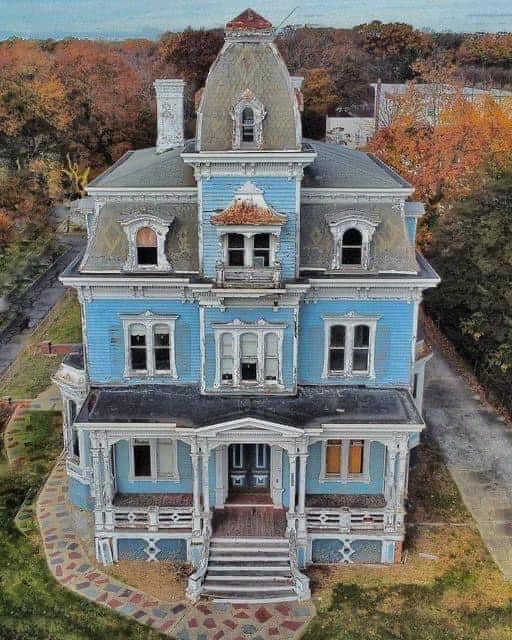Strolling along Matawan’s main street reveals a typical suburban scene, except for a particular lot that captures attention. Situated in the latter half of the street, an intriguing yet captivating structure stands out amidst the surrounding American suburbia: 226 Main Street.Known colloquially as the “Big Blue House” among locals, this three-story Victorian-style residence boasts a striking sky-blue hue, enclosed by a metal and brick fence. Crafted with French Second Empire architecture in mind, it holds the distinction of being one of only two homes of this style in New Jersey.
What makes the house truly remarkable is not just its aesthetic charm but its somewhat dilapidated state. Broken and boarded-up windows, flaking paint, a deteriorating interior, and neglected infrastructure characterize the house that has been left to decay.
Despite the apparent neglect, a “NO TRESPASSING” sign on the front gate signals its private ownership, leaving observers to ponder why such a historically significant site has been allowed to fall into disrepair.Locals familiar with the history often refer to 226 as the “Ryer House,” named after its builder and first occupant, David G. Ryer. A scion of the Ryer family, who amassed their wealth through produce trading in New York City, Ryer moved to Matawan in 1873. He became a notable figure in the community, even serving briefly as mayor.
Using his fortune, Ryer erected the grand home we see today in 1873, adopting a style that was fashionable in his time but turned out to be fleeting in American architecture. Ryer resided in the house until his passing in 1899, after which it changed hands through various occupants until 2007, when it was acquired by a new owner, Andrew Scibor.Facing significant deterioration, Scibor initially intended to convert the historic home into offices, a plan met with strong opposition from local historians and preservation organizations.
PerseveNJ, the Historic Sites Commission, and the Matawan Historical Society passionately fought to maintain the house’s original state. Their efforts were successful, leading to the rejection of the proposed plan in 2009.

Left in a state of neglect, the house remained unattended until 2019 when negotiations resurfaced. Scibor proposed transforming the house into eight new apartments, intending to renovate the interior while preserving the original Victorian exterior. This compromise, seen as a win-win by most locals, was reluctantly accepted by Matawan despite some ongoing concerns from historians and civil engineers.

However, as of now, no visible progress has been made on the renovation, leaving residents in the dark about why the “Big Blue House” still stands in a state of ruin, with both the Borough and Scibor maintaining silence on the matter.

